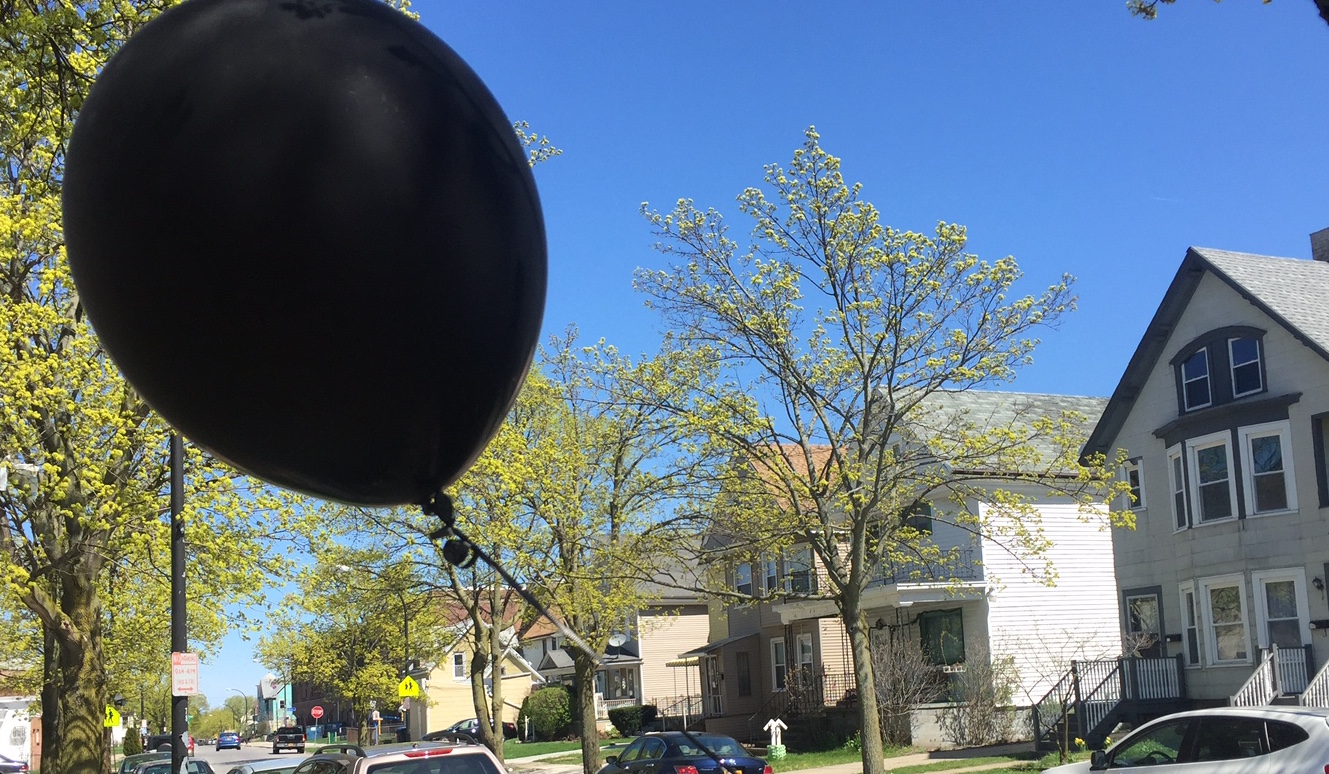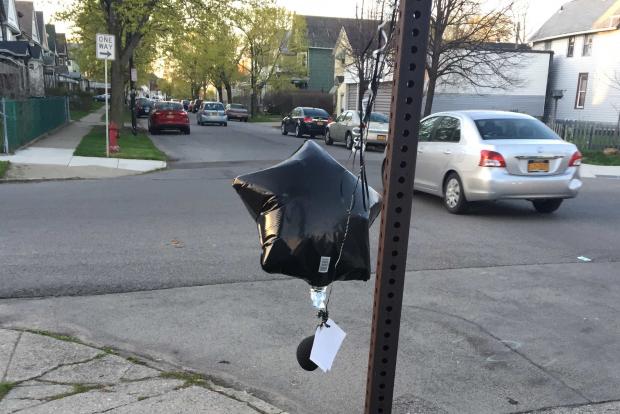A Black Balloon
Sunday morning there was a black balloon tied to the maple in front of our house on Hoyt Street. A black, nylon string tied around the tree, securing a flower underneath it, and hanging from the balloon a simple memorial: Joshua S., his date of birth in 1987 and his date of death, April 15, 2017.
The only reason I recognized the name was from a Facebook post on a neighborhood group I had formerly belonged to, West Side Alive. WSA was a community bulletin of sorts, but also a collection of strident types who wanted to tie their property values to the rising tide of the Elmwood Village and saw themselves in something of a war against the broader social and public health failures for which the West Side provides little cover. After one member posted concerns over drug dealers in an area park, a former admin of the group with a military background went so far as to suggest patrolling the park with “everything from moral support to semiautomatic weapons and a crew of serious men who are loyal to me to carry them.”
I learned Joshua’s name from a video of a young man shooting up in the backyard of a house that has since been demolished on Breckenridge Avenue, posted by a concerned resident to bring attention to a particularly troubled block of the street between Parkdale and Grant streets. He was identified by a D-District patrol officer, Tom Cino, by both his first and last names. If I remember correctly—I left the West Side Alive group and it was made private shortly after—Cino commented that he had revived Joshua from an overdose at least once previously.
Joshua’s putative sister also commented, seeking knowledge of her brother’s whereabouts, and a small conflagration erupted on the thread about the appropriateness of posting such a video to what was then a public Facebook group. The people who saw themselves on certain sides of the war to make the West Side safer saw the video as justification for ongoing vigilantism and entrenched themselves and ridiculed those who felt the video was invasion of privacy or worse: a public shaming over a disease.
I saw Joshua around the neighborhood frequently, almost daily, after the video. We never talked or greeted each other, and for mainly that reason, I’m choosing not to publish his last name. It’s strange territory to say the least, being a neighbor with people addicted to an illegal substance that promises to kill them, wondering whether or when they may be prone to flares of the kind of desperation that make a neighborhood unsafe. I never knew Joshua to be a petty criminal in the neighborhood, and I don’t recall any WSA comments of that nature, either. This might only make sense to members of a certain vintage, users would frequently post images of suspects garnered from their home surveillance systems and ask other members to keep a look out. Suffice to say, I saw him often and knew what he was up to. Walking or driving the neighborhood with my kids, I’d see him buy drugs from people and cars I’d never seen before. Tall, gawky, often smoking cigarettes, always wearing too much, usually dark clothing, most often with a backpack. He was otherwise a rather silent presence.
The ills of our culture are unmasked in poorer neighborhoods. In more affluent ones, they’re kept locked behind gates, unseen over the expansive lawns, kept in cars where there are no sidewalks. On net, recent investment and a reversal of the general feasibility of development within city limits from a no-go zone to a green light pending public subsidies, is a good thing. But as frequent contributor to The Public Bruce Fisher has pointed out, higher paying manufacturing jobs have been replaced by lower paying service industry ones, and black men in Buffalo currently have an effective unemployment rate around 40 percent. A community with a statistic like that is one that comes up short to serve its most vulnerable citizens, including a twenty-something white drug addict sleeping hidden somewhere in your backyard.

Last month Attorney General Jeff Sessions delivered a speech in which he assailed the growing tolerance for marijuana. Comparing marijuana to heroin, he said the former was “only slightly less awful” than the latter. “Our nation needs to say clearly once again that using drugs will destroy your life,” he said.
Every day, at least one resident of Erie County dies of a heroin overdose. The Buffalo News has reported 129 suspected deaths in the first 109 days of 2017. Speaking with a friend who is a nurse in the emergency room of ECMC last week, she estimated that the ER there sees 10 overdoses a day. An increase in the use by first responders of the life-saving naloxone intervention has been met with an increase of street drugs with a greater concentration of the more lethal fentanyl. I didn’t think to ask my friend how many marijuana-related overdoses she responds to, I think we all know the answer to that.
The problem with community groups that fight against dealers, sex workers, and addicts is that those groups reach satisfaction when they don’t have to confront the social reality. The NIMBYism that surfaces every time a drug treatment facility is planned in a community with higher home values is a manifestation of this. People are dropping like flies, but no one wants to help, or in my case with Joshua S, knows how to help. Is there even help? Current substance-abuse treatment methodology is at times as low as 10 percent effective. Last week Anne Constantino, president of Horizon Health Services, described the work of addiction services as “exhausting, frustrating, sad and hard” to the Erie County Legislature, as reported by the News.
It’s cheap and easy to go gangbusters on small-time dealers at the park, it’s harder to go after the more sinister party in this: the drug companies that presided over the opioid spike and political candidates with their hands out. You need money and lawyers and political will to solve these problems, but when the nation’s top law enforcement officer makes a statement that conflates lethal heroin with decidedly non-lethal marijuana, that solution slips further away.
The Erie County Legislature devoted a hearing to the issue last week. The county’s still new $375,000 per year, 24-hour hotline receives just 8-10 calls per day. Majority leader Joseph Lorigo, who successfully committed $100,000 of public money towards a PR campaign for ride-sharing earlier this year, called the program a “failure.” Apparently, the value of an addict’s life has been arrived upon; if one person’s life was saved, wouldn’t that be a success?
Since Election Day 2016, locally produced lawn signs have appeared in the neighborhood, communicating in multiple languages that it doesn’t matter where you’re from, we’re glad to have you as a neighbor. Where to draw that line on addicts and sex workers in the neighborhood is far trickier, but I don’t think it helps anyone to view them as the enemy. Their lives, their secrets are baldly exposed. Their actions threaten the cocoon of innocence we try to keep our children in. They attract people from outside the neighborhood to do things in front of our houses they would never accept being done in front of their house in Tonawanda or Hamburg. When we have visitors, we hope they won’t be able to guess what the neighbors are really up to. I don’t have the answers, but I know that neither the police, our government, nor Facebook community bulletins have shown the vision or empathy for a real solution.
There’s not just a balloon in front of my house on the middle of the block. They’re at both corners, flopping in a gentle breeze, and around the back of the block on Parkdale, too. They’ll lose their helium within a day and hang limp until the elements claim them. I don’t know what happened to Joshua in his life, or even if he died in the obvious manner. I do know that these people who have been cast aside and been unable to help themselves, almost all still have loved ones who feel powerless to save their brother, their father, their daughter, etc. And when the seemingly inevitable occurs, one of those people spends a Saturday night walking in that loved person’s shoes, tying balloons, letting everyone know that someone had, in fact, been finally lost.
The Erie County addiction hotline is 716-831-7007.

